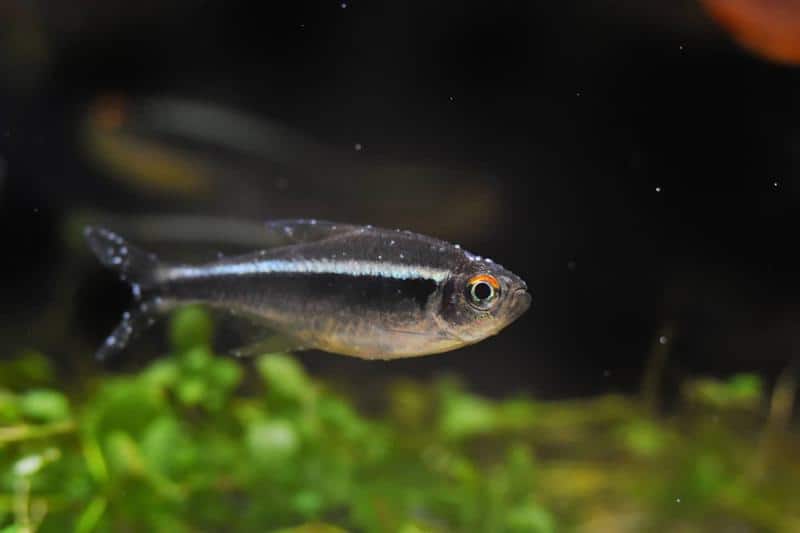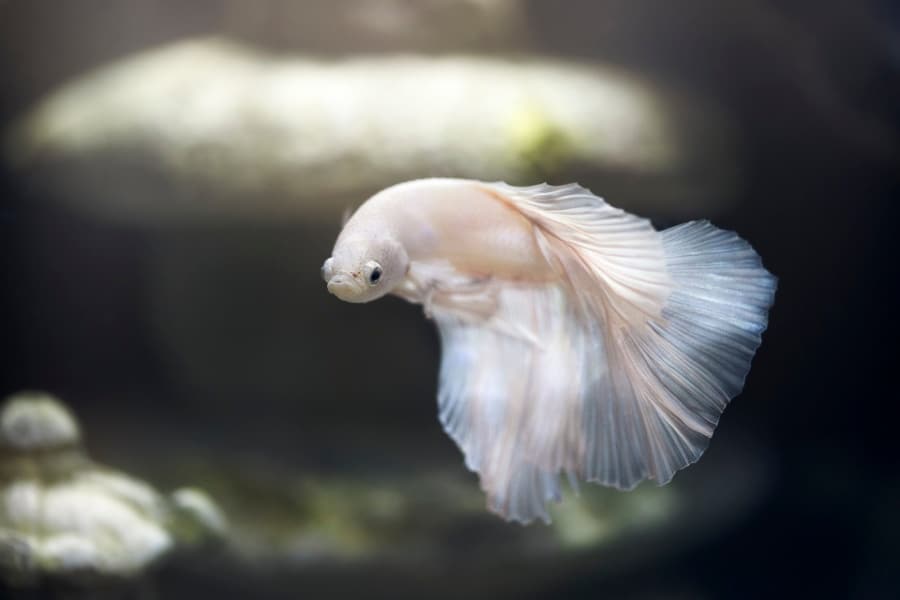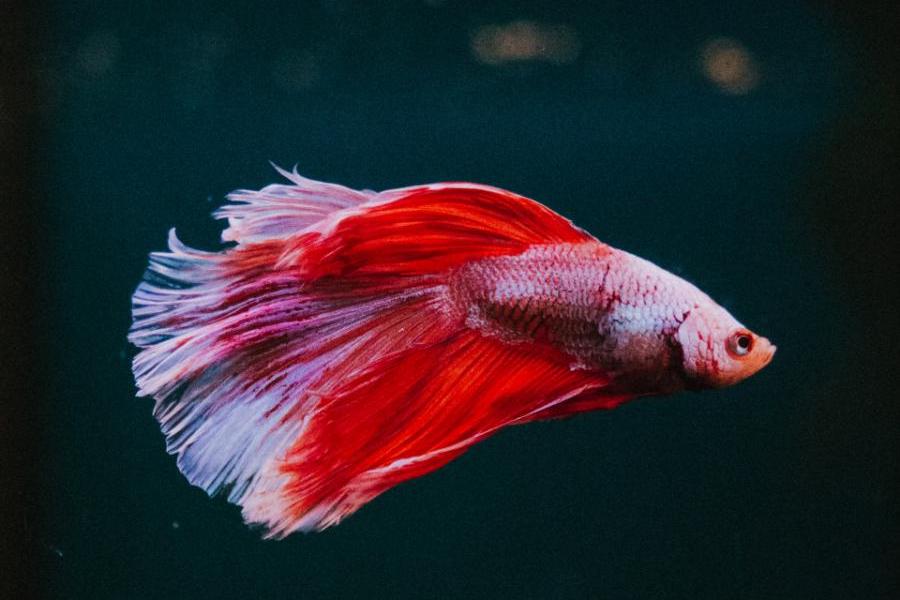Betta fish are normally beautiful and vibrant, so it can be alarming if your fish is turning white or losing color.
There are various reasons why betta fish fade in color, including illness, stress, poor water quality, and simply old age.
If you’re wondering ”why is my betta turning white?”, read on to find out the possible causes and what you can do to treat them.
Why Do Betta Fish Turn White?
Betta fish can turn white for a variety of reasons, but most cases are a sign that something is wrong, such as a bacterial or fungal infection.
Let’s dive into some of the most common causes of betta fish turning white.
Columnaris
Columnaris is a bacterial infection that can cause white/gray, fungus-like patches to appear on your betta’s body. It can also manifest as frayed fins with white edges. As the disease progresses, it can lead to scale loss and ulcerations on your betta’s skin.
Poor water quality, stress, high water temperature, and bad genetics can contribute to the development of columnaris in bettas. It’s caused by the bacteria Flavobacterium columnare and can be notoriously difficult to treat.
There are two strains of columnaris that can affect aquarium fish. The first type will usually kill your fish within 24 to 48 hours, so treatment is usually too late. If your betta fish turned white and died, it’s likely because they were infected with the first strain.
The second strain progresses slowly, which gives you more time to treat your betta. If your fish is still alive after a day or so of displaying symptoms, they are probably suffering from the second strain of columnaris.
How to Treat Columnaris in Betta Fish
- First things first, move your betta into a 5-gallon hospital tank, especially if they are housed with other fish. Columnaris is extremely contagious, so it can easily spread to other livestock in your tank.
- Lower the temperature of your water to around 23 degrees Fahrenheit as Flavobacterium columnare develops slower in colder water.
- Use medications that contain copper sulfate, terramycin, furan, and acriflavine to kill the bacteria.
- Add aquarium salt to (around 1 tablespoon per 5 gallons) to your tank water to reduce osmotic stress.
Ich

Ich (also called white spot disease) is a very common freshwater disease that can lead to your betta fish turning white and not eating properly. It’s caused by a parasite known as Ichthyophthirius multifiliis and typically infects fish that are stressed or weak.
White spot disease is easy to identify as it manifests as small white lesions on your betta’s body – it will almost look like your fish has been sprinkled in salt. Other symptoms include flashing, frayed fins, lethargy, sitting at the bottom of the tank, and loss of appetite.
How to Treat Ich in Betta Fish
- Ich is highly infectious, so you’ll likely need to treat your main tank, even if your other fish don’t display any symptoms.
- Slowly increase the temperature of your tank to 83 degrees Fahrenheit (+1 degrees every hour) as this will speed up the parasite’s life cycle and make it easier to treat.
- Use commercial ich medications that contain malachite green or methylene blue.
- Aquarium salt can also be used to eliminate mild ich infections.
Fin Rot
Another reason why your betta may have turned white is fin rot. Fin rot is common in betta fish due to their long fins and tails, but it is relatively easy to control as long as you treat it quickly.
The primary symptom of fin rot is torn or ragged fins, usually accompanied by white or black edges. Stress, poor water quality, and ripped fins caused by nippy tank mates or plastic plants can contribute to fin rot.
Fin rot can either be caused by bacteria or fungus, but it is usually due to the former. If left untreated, it can lead to fin or tail loss, so it can be very serious.
How to Treat Fin Rot in Betta Fish
- Separate your betta from your main tank if they are housed with other fish to prevent further stress.
- Improve the quality of the water in your main aquarium by performing daily water changes. Mild cases of fin rot will usually pass with clean water.
- If your betta’s fin rot is caused by aggressive tankmates, it might be best to rehome them or move your betta to a separate tank.
- Add aquarium salt or use commercial fin rot treatments that contain malachite green, phenoxyethanol, or methylene blue.
Anchor Worms
Despite their name, anchor worms are not actually worms – they’re parasitic crustaceans known as Lernaea. They look like white, thread-like pieces hanging from your betta’s body. Your fish may also have red lesions or patches on their scales.
Anchor worms are usually caused when infected fish are introduced to the aquarium without being quarantined first. Juvenile anchor worms can also be spread by new live plants, usually in the water that surrounds them.
How to Treat Anchor Worms in Betta Fish
- Isolate your betta to a hospital tank so you can treat them.
- You can manually pull the anchor worms from your betta’s body with a pair of tweezers. This is an effective treatment method, but it may be stressful for your fish.
- Aquarium salt can help remove anchor worms as most parasites are intolerant to it.
- If the other treatments don’t work, consider giving your betta a potassium permanganate bath to eliminate anchor worms.
Fungal Infection
If you notice your betta fish’s color fading or see white fuzzy growths on their body, it could be due to a fungal infection. The majority of fungal infections are caused by a pre-existing injury or infection.
However, they can also be caused by stress and bad water quality. Fish with fungal infections will have cottony, white patches on their body. They may also lose their appetite and have clamped fins.
How to Treat Fungal Infections in Betta Fish
- Fungal infections are contagious, so you may need to medicate your main tank if your betta is housed with other fish.
- Perform daily water changes to improve the quality of your water and help your betta fish recover faster.
- Use aquarium salt to help eradicate the fungus.
- If aquarium salt is ineffective, use commercial antifungal medications that contain malachite green, methylene blue, and Phenoxyethanol.
Why Is My Betta Losing Color?
It can be difficult to pinpoint the exact reason why your betta fish lost color as there are many factors that can influence a change in appearance in fish, including stress, illness, and poor water quality.
However, it’s important to identify the cause of your betta fish’s loss in color so you can choose the right treatment and, hopefully, help them regain their vibrant pigmentation. Below are some of the most common causes of a betta fish’s color fading.
Stress
If you notice your betta fish losing color and not eating, it could be due to stress. Stress in fish can lead to a weakened immune system and illness, so you need to figure out why your betta is unhappy.
This might be due to poor water quality, unsuitable tank mates, bad nutrition, or an undersized aquarium.
The best solution is to eliminate the stressor, so be sure to clean your aquarium frequently, select appropriate tank mates, use a large tank (bettas need a minimum of 5 gallons), and feed your betta a high-protein fish food.
Illness
Another reason why bettas can lose color is due to an illness or disease, especially if your betta turned white and died.
Fungal, bacterial, and parasitic infections can cause discoloration or white lesions to form on betta fish.
Other symptoms that may indicate that a fish is suffering from an illness include lethargy, poor appetite, loss of balance, abnormal swimming pattern, stringy white feces, and betta fish turning white and laying on bottom of tank.
Poor Water Quality
Another factor that can cause your betta’s color to fade is poor water quality. High levels of ammonia, nitrite, and nitrate can lead to pale coloration and make your fish very sick.
Bad water quality is normally associated with inadequate tank maintenance, so make sure you perform weekly water changes and regularly clean your tank equipment.
Bad Diet
If your betta fish lost color, it may be because they are not being given the right type of diet. Bettas are carnivorous, so they need a lot of protein to thrive. You should offer your fish a variety of foods to keep them healthy and help them regain their color.
Betta fish pellets (or fish flakes designed for carnivorous fish) should be the main staple of your betta’s diet, alongside frozen or live black worms, mosquito larvae, brine shrimp, bloodworms, and daphnia.
Be careful not to overfeed your betta – offer them food twice a day and only as much as they can eat within 2 to 3 minutes. Remove leftover food with a net to prevent fouling your aquarium water.
In addition, don’t feed your betta human food like bread, beef, poultry, pork, etc, as it could potentially harm or kill them like bread.
Old Age
It’s not uncommon for betta fish to become less vibrant as they age, so a loss in color could simply be due to your betta getting on in years.
Sadly, betta fish usually only live for between 2 to 3 years. If your pet is around this age, a slight loss in color is normal provided they are acting healthy otherwise. If your betta is losing color and not swimming, it could be a symptom of an illness/disease.
Related:
- Betta Fish Swimming Sideways: Reasons & Treatments
- Betta Fish Laying on Bottom of Tank
- Betta Fish Popeye: Early Signs, Treatment, & Care
- Goldfish Turning White: 7 Reasons & What to Do
- Betta Fish Behaviors Before Death
- Goldfish Turning Black: 5 Causes & Treatment
- Cotton Wool Disease(Columnaris)
FAQs
Why is My Betta Turning Pale?
Stress is the most likely reason why your betta is turning pale. A change in environment, poor water quality, aggressive tankmates, an undersized aquarium, and a bad diet can contribute to stress in bettas.
Can Betta Fish Regain Their Color?
Yes, betta fish can regain their color as long as you solve the reason behind your fish’s paleness. For instance, if your betta has lost their color due to dirty water conditions, improving the quality of your tank water will help enhance their pigmentation.
Final Thoughts
Betta fish can turn white and lose color for a wide range of reasons, but the most common are illness/disease, stress, and poor water quality. As long as you put in measures to fix these issues, your betta should regain their color in no time.
Remember to keep on top of your tank maintenance, quarantine new fish, and feed your betta a well-balanced diet to promote good health and prevent illness and disease.
It’s also a great idea to check for health issues on a regular basis. Doing so will allow you to react quickly if you notice anything amiss with your betta fish and, hopefully, get them back on the road to recovery much sooner.

